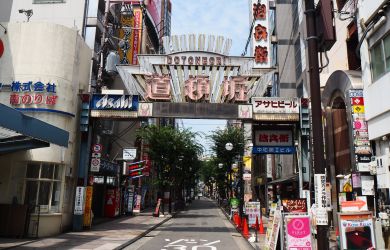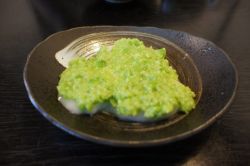
April 7, 2011
MOT Annual 2011
Tokyo’s emptiest art venue stages a requiem for the voiceless
By Metropolis
Originally published on metropolis.co.jp on April 2011

Four Color Sponges, 2011, sponges. Photos by C.B.Liddell

Sound Sphere, 2011, cassette tape

Band and Carton, 2011, cardboard box and PP band

Wood #2, 2009, hammers
Of course, many broadminded people will say I didn’t do anything wrong. Certainly it’s not like the time I accidentally kicked over some of Andy Warhol’s “Brillo Boxes” in the Guggenheim (luckily this could be repaired) or when a madman with a hammer attacked Marcel Duchamp’s found object masterpiece “Fountain” and slightly chipped the sacred porcelain of that holy urinal. But the whole point of the latest exhibition seems to be its minimalist delicacy; although my act of vandalism was extremely subtle, so is the art on display.
For those who don’t know, MOT Annual is a group show held every year since 1999 at the Museum of Contemporary Art Tokyo to showcase new trends in art. Usually, five or six young or youngish Japanese artists are selected around a theme expressed in the exhibition’s title, which is often a nebulous phrase badly translated into English. This year’s Japanese title (“Sekai no Fukasa no Hakarikata”), which even Babelfish can quite accurately render as “How to Measure the Depth of the World,” becomes by some miracle of linguistic alchemy “Nearest Faraway,” which certainly takes things further away from actually meaning anything.
So, what is the big artistic trend unveiled by this show? Unfortunately, given the perilous state of Japan, which calls for death-defying heroics combined with Stakhanovite efforts to distribute much needed supplies to stricken communities, the trend is for extremely entropic, low-key art that would fit neatly into a warehouse. Take, for example, Motohiro Tomii (b. 1973), whose work essentially consists of placing lots of everyday objects in the simplest possible formations. If Japan can survive its present troubles, I suspect a job as an expert shelf-stacker beckons for this young man.
More intriguing is the cassette-tape-obsessed art of Lyota Yagi (b. 1980), which makes points about disappearing analog systems in our iPod world. His main works here are a number of extremely light “sound orbs” made from cassette tape. They can be played like spherical records, although the sound produced is just a tiny crackling sound.
I suspect that both Tomii and Yagi don’t get out much. The mental image of the artists conjured up by their art suggests obsessive introverts bordering on hikikomori. This impression is even stronger with the work of Akiko Ikeuchi (b. 1967), who creates extremely delicate and difficult-to-see webs of silken threads that take up a lot of space, freezing it into a sterile, dainty silence.
I’m sure that if I ever met Ms. Ikeuchi I would have to lower my voice to a whisper and avoid eye contact, or the poor girl would shrink into her shell. Yes, the younger generation of Japanese artists has certainly come a long way from the days when every artist had syphilis, drank like a fish, beat up reviewers, cut off body parts to impress prostitutes, and still managed to invent a new “ism” before teatime.
Of course, this show was arranged before the great quake, and certainly sends out a very timid message. We can only hope that next year, as a result of the greater vandalism dealt out by tectonic forces, we’ll see a resurgence of much more vigorous art.
Museum of Contemporary Art, Tokyo. Until May 8, free (elem and under)/¥550 (MS, HS)/¥850 (univ, 65 and over)/¥1,100 (general). 4-1-1 Miyoshi, Koto-ku. Open Tue-Sun 10am-8pm, closed Mon. Nearest stn: Kiyosumi-Shirakawa. www.mot-art-museum.jp





